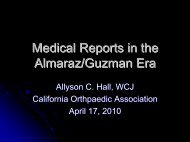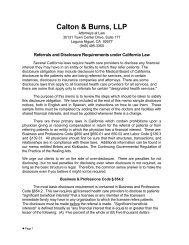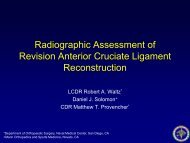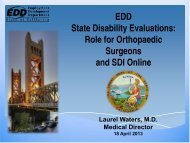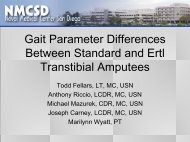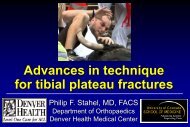Enhancing Your Practice's Revenue - California Orthopaedic ...
Enhancing Your Practice's Revenue - California Orthopaedic ...
Enhancing Your Practice's Revenue - California Orthopaedic ...
- No tags were found...
You also want an ePaper? Increase the reach of your titles
YUMPU automatically turns print PDFs into web optimized ePapers that Google loves.
develop and oversee the plan? Oftentimes this falls to oneor more of the physicians who are interested in developingthe ASC. However, physicians in general, and orthopaedistsin particular, are typically very busy people with little freetime. Further, historically at least, physicians have notalways been as astute in business as they are in providingpatient care - - although this is changing as more and morephysicians secure MBA and MHA degrees.An alternative to the above approach is to empower ahospital executive (if the practice plans to enter into a jointventure – more on this in a moment) or employ an outsideconsultant. The advantage of using an outside consultantis that he or she will have expertise in project managementand (hopefully) facilitate the completion of the ASC ontime and within budget. The downside is that this will costmoney, and hence increase the overall budget.Regardless of who is in charge of the project, the first stepin any plan to develop an ASC is for the physicians to cometo an agreement regarding mission, goals and objectives.They need to decide (a) why they are developing the center,(b) what services the center will be providing, (c) to whom,(c) when, (d) where and (e) how. The first question (why)is particularly challenging. Presumably the purpose of theASC is to make a profit, but in addition, the practice maywish to accomplish other things, including, for example,improve the quality of health care provided to patientsand/or to maintain good relations with a nearby healthcareinstitution.Further, even “making a profit” is an imprecise goal. Dothe doctors have a minimum return on investment in mindor is it sufficient that the ASC have a positive cash flowafter X years have passed? It is crucial that physicians cometo closure regarding its mission or the center will almostcertainly not be successful in the long term. For more information,See # 2 in Ten Top Tips, in the Appendix.Another basic element of any plan is the creation of a proforma, or a spreadsheet projecting revenues and expensesfor the ASC over a period of at least eight years. This issomething that a consultant is likely to have expertisein, even if individual physician investors do not. The proforma needs to be reality-based and conservative becausepeople do not want to put their money at risk. This is thecase whether physicians invest out of their own savings/investments or turn to a bank or other financial institution.Pro formas will be covered in greater detail in the Financesection, below.Go It Alone vs. Partner with a Third PartyIn developing an ASC, the advantages to physicians of“going it alone” are:• The doctors may be more selective in including only thehighest quality healthcare providers.• They retain control of administrative and quality of carematters.• Profits do not need to be shared with any other party.The downsides are:• Physicians must come up with the required money (outof savings or borrowed from third sources).• They assume all the risk if the venture is a failure.• They may not have the expertise to oversee the business.• Nearby hospitals may feel that an income stream will bethreatened and retaliate.The advantages to physicians of partnering with a thirdparty (e.g., the hospital or surgery center/real estatemanagement company) are:• The initial investment for physicians will be less than itotherwise would be.• If the venture is a failure, physicians’ financial exposureis lower.• The hospital may be in a position to providemanagement expertise in operations.The downsides are:• The physicians lose at least a certain amount ofadministrative and clinical control.• Profits from the center are divided among a greatnumber of parties.• The hospital’s notion of high-quality management maynot be the same as the doctors’.There are, of course, options in between the two extremesdescribed above. For example, if the center isinitially entirely physician-owned, the doctors could sell apercentage of their ownership to an outside interest afterthe center becomes successful and realize a profit. Thedownside to that approach is that future profits will bereduced and operational control decreased.Alternatively, if the ASC is organized as a JV, physicianscould buy out the other stakeholders in the future. However,if the center is successful, this will cost money whichmust come from somewhere.In the ultimate analysis, whether the physicians choose to“go it alone” or partner with a third party may be dictatedby the size of the initial and subsequent capital investments.The larger the ASC, the greater the required up-frontfinancial commitment. Further, most ASCs will likely willnot be self-supporting for several years, during which timecapital infusions will be required.Physical Facility Location and DesignThe real estate dictum “location, location, location” appliesto planning for the ASC. It needs to be convenient for© 2011 American Academy of <strong>Orthopaedic</strong> Surgeons19




